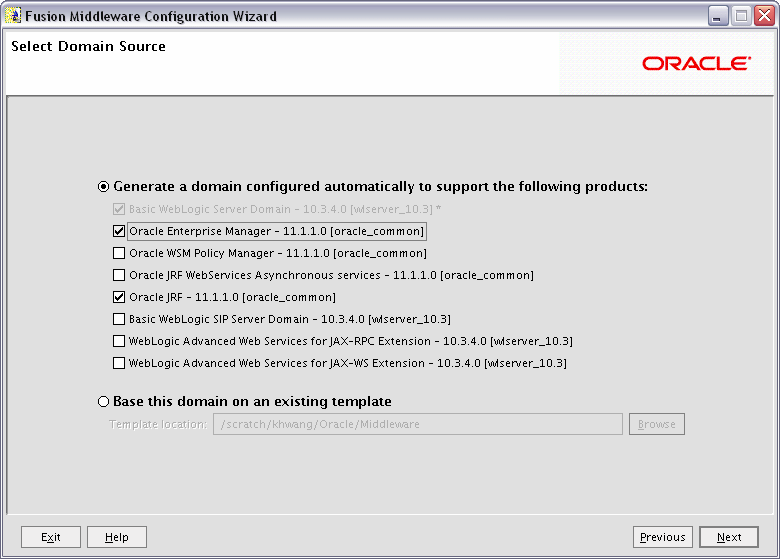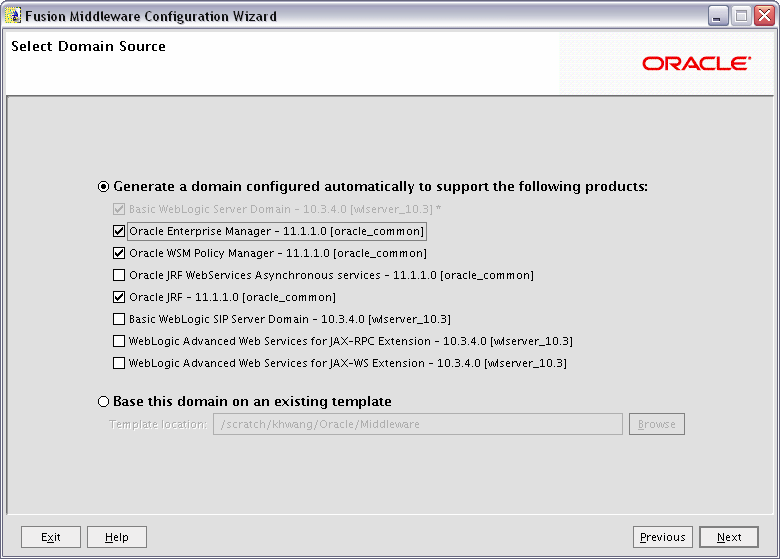2 Configuring Application Developer
This chapter describes how to configure Application Developer and create or extend a WebLogic Domain after the software has already been installed or patched to the latest version.
The following topics are covered:
2.1 Configuration Instructions
After the installation is complete, you can configure the components using the Fusion Middleware Configuration Wizard. The instructions in this section describe how to do so.
This section contains the following content:
2.1.1 Starting the Configuration Wizard
The Configuration Wizard is located in the common/bin directory inside the product Oracle home. To start the Configuration Wizard:
On UNIX operating systems:
cd MW_HOME/oracle_common/common/bin
./config.sh
On Windows operating systems:
cd MW_HOME\oracle_common\common\bin
config.cmd
If this is a new installation and you need to create a new WebLogic domain, follow the instructions in Section 2.1.3, "Creating a New Domain". You can also run the Configuration Wizard to extend an existing WebLogic domain, as described in Section 2.1.4, "Extending an Existing Domain".
If you are using a 32-bit operating system, Oracle JRockit SDK is installed as part of the Oracle WebLogic installation. This is the JDK that the Configuration Wizard will use by default. If you want to invoke the Configuration Wizard with the Sun JDK, do the following prior to starting the Configuration Wizard:
-
Set the
JAVA_HOMEenvironment variable to the location of the Sun JDK. For example, you can set it to the Sun JDK that was installed with Oracle WebLogic Server in theMW_HOME/jdk160_21(on UNIX operating systems) orMW_HOME\jdk160_21(on Windows operating systems) directory. -
Set the
JAVA_VENDORenvironment variable to "Sun".
2.1.2 Configuration Log Files
To create a log file for your configuration session, use the -log=log_filename parameter when you start the Configuration Wizard.
On UNIX operating systems:
./config.sh -log=log_filename
On Windows operating systems:
config.cmd -log=log_filename
Log files of your configuration session are created in the MW_HOME/oracle_common/common/bin (on UNIX operating systems) or MW_HOME\oracle_common\common\bin (on Windows operating systems) directory. For more information about the Configuration Wizard log files, see Section D.2.2, "Configuration Log Files".
2.1.3 Creating a New Domain
Follow the instructions in "Creating a WebLogic Domain" in Oracle Fusion Middleware Creating Domains Using the Configuration Wizard to create a new WebLogic domain for your Oracle Application Developer components.
2.1.3.1 Configuring Oracle Enterprise Manager
If you want to configure Oracle Enterprise Manager in your domain, you must select "Oracle Enterprise Manager - 11.1.1.0 (oracle_common)" on the Select Domain Source screen, as shown below:

Description of the illustration config_em.gif
Note that "Oracle JRF - 11.1.1.0 (oracle_common)" is automatically selected as a dependency.
2.1.3.2 Configuring Oracle Web Services Manager (OWSM) Policy Manager
You can create a domain with Oracle Web Services Manager (OWSM) Policy Manager to secure JAX-WS clients and web services deployed in your environment. On the Select Domain Source screen in the Configuration Wizard, select the following options, as shown in the figure below:
-
"Oracle WSM Policy Manager - 11.1.1.0 (oracle_common)"
-
"Oracle Enterprise Manager - 11.1.1.0 (oracle_common)"
-
"Oracle JRF - 11.1.1.0 (oracle_common)"

Description of the illustration config_owsm.gif
2.1.3.3 Applying Java Required Files (JRF)
Java Required Files (JRF) consists of those components not included in the Oracle WebLogic Server installation and that provide common functionality for Oracle business applications and application frameworks.
JRF consists of a number of independently developed libraries and applications that are deployed into a common location. The components that are considered part of Java Required Files include: Oracle Application Development Framework, Oracle Fusion Middleware Audit Framework, Dynamic Monitoring Service, Infrastructure Security, Java Object Cache, Oracle Platform Security Services, logging, MDS, Oracle Web Services, and Oracle Web Services Manager.
You must apply JRF to a Managed Server or cluster in certain circumstances.You can only apply JRF to Managed Servers that are in a domain in which JRF was configured. That is, you must have selected Oracle JRF in the Configuration Wizard when you created or extended the domain.
For more information, see "Applying Java Required Files to a Managed Server or Cluster" in Oracle Fusion Middleware Administrator's Guide.
2.1.3.4 Using Custom Port Numbers
By default, the servers that are created in each domain use the same set of port numbers (for example, the Administration Server uses port 7001). If you want to use custom port numbers, you can change the port number when you run the Configuration Wizard:
-
The Administration Server port number can be changed on the Configure Administration Server Screen.
-
The port number for all managed servers in your domain can be changed on the Configure Managed Servers Screen.
Fore more information about port numbers, refer to "Port Numbers" in Oracle Fusion Middleware Administrator's Guide.
2.1.4 Extending an Existing Domain
While creating your WebLogic domain, if you chose not to configure all of the components on the Select Domain Source Screen, you can add these components at a later date by extending your domain. If this is a first time installation or you do not want to add more components, you can skip this section and move to the next section.
Note:
Before proceeding, make sure that schemas exist in your database for the components you are configuring when you extend the domain. For example, if you are planning to extend the domain and configure Oracle WSM Policy Manager, then make sure the required schema for this component (MDS) exists in your Oracle database before you continue.Follow the instructions in "Extending a WebLogic Domain" inOracle Fusion Middleware Creating Domains Using the Configuration Wizard to extend an existing domain.
2.2 Starting the Administration Server
To get your deployments up and running, you must start the Administration Server by running the startWebLogic.sh (on UNIX operating systems) or startWebLogic.cmd (on Windows operating systems) script in the directory where you created your new domain.
On UNIX systems:
DOMAIN_HOME/startWebLogic.sh
On Windows systems:
DOMAIN_HOME\startWebLogic.cmd
You entered the domain name and location on the Specify Domain Name and Location Screen in the Configuration Wizard.
2.3 Verifying the Installation
To verify the installation, start your browser and enter the following URLs:
-
To access the Administration Server console:
http://administration_server_host:administration_server_port/console
-
If you configured your Administration Server to accept SSL connection, use the following URL to access the Administration Server console in secure mode:
https://administration_server_host:secure_administration_server_port/console
-
http://administration_server_host:administration_server_port/em